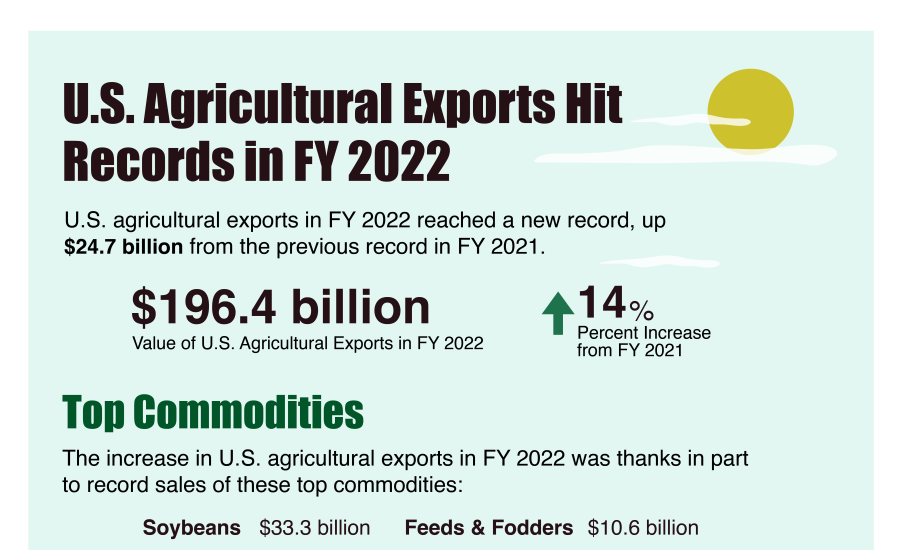Browse Data and Analysis
Filter
Search Data and Analysis
- 1268 results found
- (-) Oilseeds
- Clear all
Post increased the 2022/23 forecast for soybean planted area expansion to 43.3 million hectares (ha) and soybean production to 153 million metric tons (MMT). This season sowing began optimistically, with most soybeans planted on time compared to last year. However, in the southern part of the country including Rio Grande do Sul and Parana, rains will be needed in January because if continues to be dry, the crop will be negatively impacted.
U.S. agricultural exports to China in fiscal year (FY) 2022 were $36.4 billion and surpassed the previous year’s record with China as the largest export market for the second consecutive year. Significantly higher agricultural prices and resilient demand helped drive exports above the previous year’s record despite lower volumes for most products.
Post maintains the projections for 2021/22 and updates MY 2022/23 with an optimistic outlook on production resulting from good weather conditions and an improved labor situation.
Since January 1, 2021, the UK has been responsible for authorizing products of genetic engineering (GE) using retained EU law. Eight GE crops are currently out for public consultation as part of the second tranche of approvals under the new UK...
Mexico has not officially reported any approvals for genetically engineered (GE) agricultural products for food and feed use since May 2018. Additionally, Mexico has not approved any permit applications for cultivation of GE crop (cotton and alfalfa)...
India’s soybean, peanut, and sunflowerseed production for marketing year (MY) 2022/23 (October-September) is estimated at 11.1 million metric tons (MMT), 6.65 MMT, and 200,000 metric tons, respectively, reflecting heavy late season rainfall in September and October that impacted yields and crop quality.
On larger than expected production loss related Indonesia’s palm oil export ban policy, Post revises down Indonesia palm oil production to 44.7 million ton (MMT) for 2022/23 and updates 2021/22 production to 43.2 MMT. Soybean imports for 2022/23 are forecast at 2.6 MMT on continued demand from tofu and tempeh producers.
Due to uncertainty regarding policy on imported soybeans, the 2022/23 soybean import forecast is reduced from 2.5 to 2.2 million tons. Due to the lower expected soybean imports, 2022/23 crush and soybean meal output is reduced accordingly. Reflecting continued decline in consumer purchasing power due to record level inflation, the forecast for 2022/23 palm oil imports is also reduced.
Côte d’Ivoire has become one of the major palm oil producers on the continent. Since 2018, the country has produced more than 500,000MT yearly. Currently, production is expected to increase 26 percent in MY2022/23 while demand outweighs supply.
Brazil is the fourth-largest export destination for U.S. agricultural and processed products in South America and depends on international suppliers to meet its demand for food processing ingredients, especially specialty products with high added value. These products offer significant opportunities for U.S. companies to supply Brazilian food manufacturers looking to meet the needs of a growing health-conscious consumer market.
FY2022 agricultural exports reach record levels.
China’s marketing year (MY) 22/23 soybean production is forecast to reach a near-record 19 million metric tons (MMT) on higher yields. Post maintains forecasted MY 22/23 soybean imports at 96.5 MMT on higher demand for soybean meal (SBM) for swine and poultry and vegetable oil demand for food sector use. Import growth is forecast to be partially constrained by higher domestic soybean production, ongoing sales of state reserve soybeans, and ongoing uncertainty regarding People’s Republic of China (PRC) COVID restrictions.

